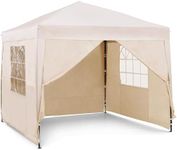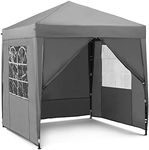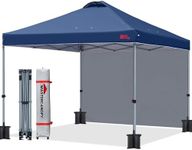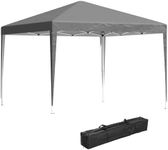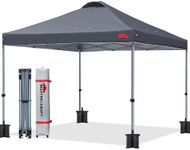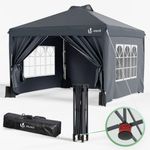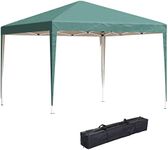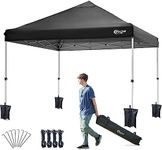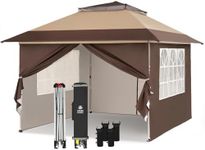Buying Guide for the Best Pop Up Gazebo
Choosing the right pop-up gazebo can make a significant difference in your outdoor experience, whether you're hosting a party, camping, or just looking for some shade in your backyard. To find the best fit for your needs, consider the following key specifications and understand how they impact the gazebo's performance and suitability for different situations.SizeThe size of a pop-up gazebo is crucial because it determines how much space you will have underneath it. Gazebos come in various sizes, typically ranging from small (6x6 feet) to large (12x12 feet or more). If you need a gazebo for a small gathering or personal use, a smaller size might be sufficient. For larger events or more extensive coverage, opt for a bigger size. Consider the number of people you want to accommodate and the space available in your yard or event area.
MaterialThe material of the gazebo affects its durability, weight, and weather resistance. Common materials include polyester, vinyl, and canvas for the canopy, and steel or aluminum for the frame. Polyester is lightweight and water-resistant, making it suitable for casual use. Vinyl offers better waterproofing and UV protection, ideal for frequent outdoor events. Canvas is durable but heavier, suitable for long-term use. Steel frames are sturdy but heavier, while aluminum frames are lightweight and rust-resistant. Choose materials based on your intended use and the weather conditions in your area.
Ease of SetupEase of setup is important, especially if you plan to use the gazebo frequently or move it around. Pop-up gazebos are designed for quick assembly, but some models are easier to set up than others. Look for features like pre-attached frames, push-button mechanisms, and clear instructions. If you need a gazebo for spontaneous events or camping, prioritize models that can be set up by one person in a few minutes. For more permanent installations, ease of setup might be less critical.
Weather ResistanceWeather resistance refers to how well the gazebo can withstand various weather conditions, including rain, wind, and sun. Look for features like waterproof canopies, UV protection, and wind vents. Waterproof canopies are essential for rainy conditions, while UV protection helps prevent sun damage. Wind vents allow air to flow through, reducing the risk of the gazebo being blown away. Consider the typical weather in your area and choose a gazebo that offers adequate protection.
PortabilityPortability is a key factor if you plan to transport the gazebo to different locations. Lightweight materials, compact folding designs, and carrying bags enhance portability. Aluminum frames and polyester canopies are generally lighter and easier to carry. Some gazebos come with wheeled bags for convenient transport. If you need a gazebo for camping, beach trips, or events away from home, prioritize portability features.
StabilityStability ensures that the gazebo remains secure and upright, even in windy conditions. Features like sturdy frames, anchor points, and guy ropes contribute to stability. Steel frames are typically more stable than aluminum, but they are heavier. Anchor points and guy ropes help secure the gazebo to the ground. If you live in a windy area or plan to use the gazebo in exposed locations, focus on stability features to prevent accidents.

